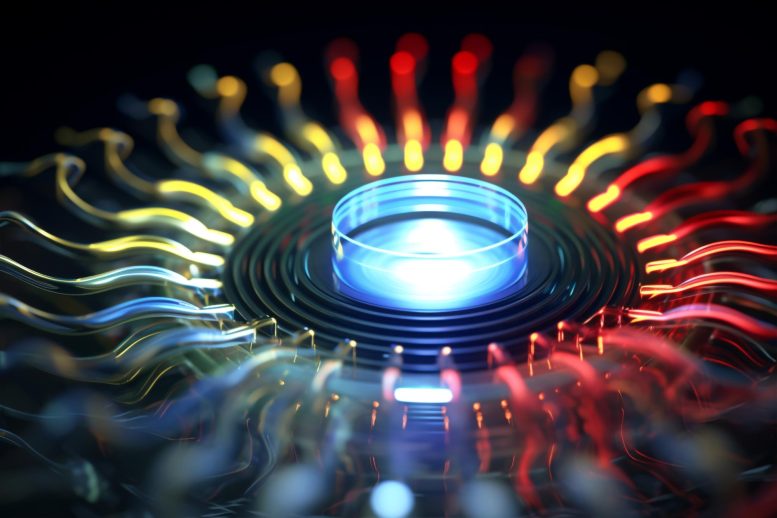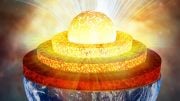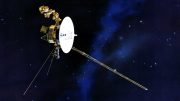
A recent study has identified the “orbital Hall effect,” a phenomenon that could significantly improve data storage in future computer devices. This discovery, involving the generation of electricity by electron’s orbital movement, offers potential advancements in the field of spintronics, leading to more efficient, faster, and reliable magnetic materials. Credit: SciTechDaily.com
Research suggests a novel approach to enhance spintronics, paving the way for advancements in future technology.
In a new breakthrough, researchers have used a novel technique to confirm a previously undetected physics phenomenon that could be used to improve data storage in the next generation of computer devices.
Spintronic memories, utilized in advanced computers and satellites, leverage the magnetic states produced by the intrinsic angular momentum of electrons for data storage and retrieval. Depending on its physical motion, an electron’s spin produces a magnetic current. Known as the “spin Hall effect,” this has key applications for magnetic materials across many different fields, ranging from low-power electronics to fundamental quantum mechanics.
More recently, scientists have found that electrons are also capable of generating electricity through a second kind of movement: orbital angular momentum, similar to how Earth revolves around the sun. This is known as the “orbital Hall effect,” said Roland Kawakami, co-author of the study and a professor in physics at The Ohio State University.
A Method to Observe the Orbital Hall Effect
Theorists predicted that by using light transition metals – materials that have weak spin Hall currents – magnetic currents generated by the orbital Hall effect would be easier to spot flowing alongside them. Until now, directly detecting such a thing has been a challenge, but the study, led by Igor Lyalin, a graduate student in physics, and published in the journal Physical Review Letters, showed a method to observe the effect.
“Over the decades, there’s been a continuous discovery of various Hall effects,‘’ said Kawakami. “But the idea of these orbital currents is really a brand new one. The difficulty is that they are mixed with spin currents in typical heavy metals and it’s difficult to tell them apart.”
Instead, Kawakami’s team demonstrated the orbital Hall effect by reflecting polarized light, in this case, a laser, onto various thin films of the light metal chromium to probe the metal’s atoms for a potential build-up of orbital angular momentum. After nearly a year of painstaking measurements, researchers were able to detect a clear magneto-optical signal which showed that electrons gathered at one end of the film exhibited strong orbital Hall effect characteristics.
Implications for Future Spintronics Applications
This successful detection could have huge consequences for future spintronics applications, said Kawakami.
“The concept of spintronics has been around for about 25 years or so, and while it’s been really good for various memory applications, now people are trying to go further,” he said. “Now, one of the field’s biggest goals is to reduce the amount of energy consumed because that’s the limiting factor for jacking up performance.”
Lowering the total amount of energy needed for future magnetic materials to operate well could potentially enable lower power consumption, higher speeds, and higher reliability, as well as help to extend the technology’s lifespan. Utilizing orbital currents instead of spin currents could possibly save both time and money in the long term, said Kawakami.
Noting that this research opens up a way to learn more about how these strange physics phenomena arise in other kinds of metals, the researchers say they want to continue delving into the complex connection between spin Hall effects and orbital Hall effects.
Reference: “Magneto-Optical Detection of the Orbital Hall Effect in Chromium” by Igor Lyalin, Sanaz Alikhah, Marco Berritta, Peter M. Oppeneer and Roland K. Kawakami, 11 October 2023, Physical Review Letters.
DOI: 10.1103/PhysRevLett.131.156702
Co-authors were Sanaz Alikhah and Peter M. Oppeneer of Uppsala University and Marco Berritta of both Uppsala University and the University of Exeter. This work was supported by the National Science Foundation, the Swedish Research Council, the Swedish National Infrastructure for Computing, and the K. and A. Wallenberg Foundation.









The concept of spintronics has been around for about 25 years or so, and while it’s been really good for various memory applications, now people are trying to go further. They want to continue delving into the complex connection between spin Hall effects and orbital Hall effects. This is very good.
In particle physics, an elementary particle or fundamental particle is not composed of other particles. Dirac equation predicted every fundamental particle in the universe has an antiparticle – its identical twin but with opposite charge.
That is to say, elementary particles have the following physical characteristics:
1. It is not composed of other particles.
2. It is a pair by particles and its identical anti-particles.
However, there are no evidences that the particles currently thought to be elementary include the fundamental fermions (quarks, leptons, antiquarks, and antileptons), as well as the fundamental bosons (gauge bosons and the Higgs boson) and the imagined neutrinos, must be the elementary particles undoubtedly. If they are composed of other particles, they will only be microscopic particles, not the elementary particles.
According to the modern discoveries in physics, fundamental forces and elementary particles can be written in terms of a pair of physical and virtual fields.
In physics, topological vortex and anti-vortex fields always appear in pairs. They perfectly reflect the exact symmetry under the simultaneous transformation of parity conservation (P), charge conjugation (C) and time reversal (T). [1]
Topological vortex and anti-vortex field pairs can generate or annihilate at the limit points, and encounter, split or merge at the bifurcation points of the 3-dimensional vector order parameter, and form topological bifurcations by unstable point defects system [2]. This means that the topological bifurcations can be the fundamental understructure of various microscopic particles. Topological vortex and anti-vortex field pairs had all the physical characteristics of elementary particles.
Elementary particles are the foundation of all things. In the presence of dissipation they can form microscopic particles in many forms. Parity conservation (P), charge conjugation (C) and time reversal (T) are the nature feature of elementary particles. As one of the microscopic particles, θ and τ are composed of elementary particles. The parity conservation of θ and τ only allows each of them respond to external forces as an independent whole, is not whether they are symmetric. There are no evidences to support that θ and τ are the same particle or mirror images of each other in nature.
Parity non-conservation in weak interactions is a hypothesis. The experimental test by to detect the beta (β) decay of Cobalt-60 oriented nuclei is not strictly scientific.
If you are interested, you can browse https://zhuanlan.zhihu.com/p/468107219.
A correct theory is beneficial for correct thinking. Wishing you all success.
Novel is key concept think outside the box, as stated the gathering at one end to show orbitale hall effect possible I think as slowing hall effect down, and the vortex of residual charge is detectable, anything that moves within our closed system on earth has a vortex grappling effect like a vortex generator on aircraft that pulls the air to the surface, maybe one day we will devise a transition of the speed of light down to what physics speed is at the quantum level orbital speed or up in speed, I couldn’t think of weather that speed would be slower or faster if faster that could change physics.